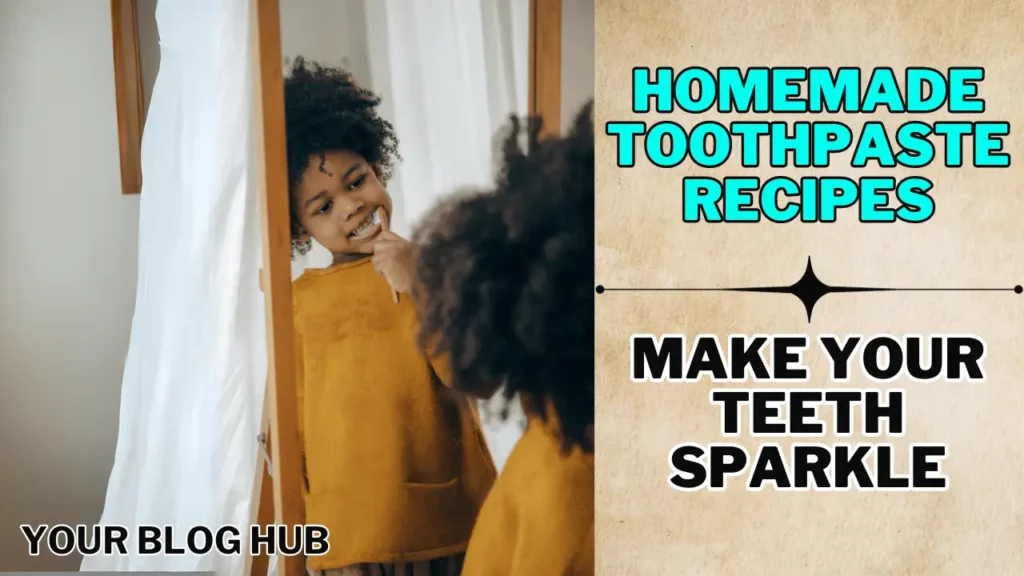You may use charcoal, coconut oil, or baking soda to produce your own Homemade toothpaste. It’s inexpensive, easy on the environment, and enjoyable to make. So let’s shake things up and move aside, mint!
Are you sick of using the same old boring toothpaste and want to give your teeth a bit more shine? So be ready to take a different approach and go on a dental adventure!
You don’t have to use store-bought, generic toothpaste. Nope, diversity makes life more interesting. So why not learn the art of natural toothpaste mixing and produce a masterpiece of oral hygiene devoid of dubious ingredients or chemicals?
Everything you need to know about creating your own toothpaste is provided here, along with information on the best components, advantages, and any drawbacks.

Homemade toothpaste benefits
It works well to use toothpaste from the generic supermarket. But every time, the flavours are always the same, dull ones. Yawn. Furthermore, a lot of the time it contains unhealthy chemicals, detergents, sweeteners, colorings, and preservatives.
In contrast, making your own toothpaste at home is a very effective, customisable, and environmentally friendly do-it-yourself activity for your oral health. You are a mixologist when you use homemade toothpaste. You get to mix and match flavours and ingredients to create a delicious and potent mixture that will leave your teeth looking their best.
Major perk: You’ll save cash! The inexpensive yet very valuable components included in natural toothpaste
Moreover, homemade toothpaste has the following advantages:
- Control: The wheel is in your hands! You may choose powerful plant-based components in place of additional nastiness and maintain total control over every ingredient in your natural toothpaste.
- Choice: Don’t like mint? Not an issue. Make whatever flavour toothpaste you choose with some essential oils of ginger, orange, grapefruit, or lemon!
- Cost: Making toothpaste at home is a cost-efficient option. You may buy a lot of the materials in bulk and use them to manufacture several batches of toothpaste. This implies that you may have a fresh supply of toothpaste anytime you need it and ultimately save money.
- Eco-conscious: When you make your DIY toothpaste, you can use reusable containers and avoid all the plastic tubes that end up in landfills. Additionally, you’ll feel good about yourself because you won’t be adding to the harm that energy-intensive manufacturing processes bring to the environment
But taking care of the environment and conserving money are not the only goals. A creative and enjoyable approach to take charge of your dental health is to make your own toothpaste. Now that you know why your teeth are more yellow than Sponge Bob, let’s look at some natural whitening toothpaste recipes.
Downsides of using homemade toothpaste
Effective toothpaste is an essential, and homemade toothpaste meets that need. Nevertheless, using all-natural toothpaste might come with certain risks.
In the first place, unless you are a dental professional, it might be difficult to achieve the exact component balance. A sprinkle of turmeric or a drop of tea tree oil may seem like a sophisticated addition, but using too much of a good thing might backfire. overly acidic or overly abrasive toothpaste might be what you get, which could irritate your gums or erode your tooth enamel.
And there’s the fluoride issue. You cannot add this mineral to a homemade dish, despite the fact that many experts believe it to be crucial for maintaining dental health and preventing tooth decay. Therefore, you may be putting yourself at a higher risk of getting cavities.
Lastly, we must not overlook the possibility of contamination. Since homemade toothpaste lacks the same safety precautions as toothpaste purchased from stores, there is a higher possibility that germs or other harmful substances will inadvertently enter your combination when you are making it or using it.
Therefore, there’s a danger that your toothpaste may turn into a haven for bacteria unless you’re producing it in a sterile facility and storing it in extremely clean settings. Horrible!
P.S. Homemade items don’t last as long as store-bought ones, so watch out for your toothpaste and throw it out if it starts to smell or look strange.
Homemade baking soda toothpaste
If you’re prepared to improve your toothpaste regimen, let’s start with a common kitchen item and transform it into an effective instrument for maintaining good dental hygiene. The main component in this homemade toothpaste recipe is baking soda, of course, but you may add whatever essential oils you prefer for flavour and aroma.
Psst: Baking soda has the potential to be really harsh on teeth. Therefore, if your teeth or gums are sensitive, continue with caution.
Ingredients:
- 1/2 cup baking soda
- 1 tablespoon water
- 1-2 drops of peppermint or other essential oil (optional)
- 1-2 drops of stevia (optional)
Instructions:
- Mix the baking soda and water oil in a small bowl until it forms a thick paste. If the mixture is too dry, you can add a little more water until you get the desired consistency.
- Add in the essential oil and stevia (if using) and mix until well combined. The oil will give your toothpaste a tasty hint of flavor, while the stevia will provide a natural sweetener that can help fight cavities.
- Transfer the toothpaste to a small container with a lid, such as a jar or a tube, and store it in a cool, dry place.
Homemade coconut oil toothpaste
Making your own coconut oil toothpaste is a simple, moisturising, and refreshing way to treat your teeth. It’s like taking a tropical vacation for your teeth. Since coconut oil may destroy germs, reduce plaque, and prevent gum disease, people have been using it as an efficient dental hygiene product for millennia.
Ingredients:
- 1/4 cup organic coconut oil
- 2-3 teaspoons of baking soda
- 1-2 teaspoons of organic arrowroot powder (optional)
- 1-2 drops of peppermint or other essential oil (optional)
Instructions:
- Mix the coconut oil and baking soda in a small bowl until well combined. You may need to melt the coconut oil if it’s solid. The mixture should be smooth and creamy.
- Add a few drops of peppermint or other essential oil if you like the flavor, and mix until well combined.
- Add the arrowroot powder to thicken the mixture if you prefer it to be less runny. Start with a small amount, and add more until desired thickness is reached.
- Transfer the toothpaste to a small container and store it in a cool, dry place.
Homemade charcoal toothpaste recipe
The rockstar of dental hygiene, homemade charcoal toothpaste is strong, gritty, and black. Because it may lighten teeth and eliminate surface stains, it is a common component in toothpaste.
A black, porous material known as charcoal is created by burning wood to a high temperature without the presence of oxygen. Don’t panic, though. You’re not required to light a fire! Alternatively, activated charcoal is available as a ready-made powder.
Ingredients:
- 1/2 teaspoon activated charcoal
- 2 tablespoons baking soda
- 2 tablespoons coconut oil
- 1–2 drops of essential oil (optional)
- 1-2 drops of stevia (optional)
Instructions:
- Mix the baking soda and activated charcoal powder in a small bowl until well combined.
- Add in the coconut oil and mix until a smooth paste forms. You may need to melt the coconut oil if it’s solid.
- Add in the essential oil of your choice and stevia if you’re using them, and mix until well combined.
- Transfer the toothpaste to a small container with a lid and store in a cool, dry place.
Is charcoal toothpaste safe to use?
Some people use charcoal toothpaste religiously because they believe it may whiten teeth and promote better dental health. However there can be some disadvantages to using grittier, black toothpaste. The primary problem is its extreme abrasiveness. That means that if you use it too often or too hard, it could do more harm than good to your teeth.
Therefore, it’s best to utilise it sparingly as opposed to frequently. It makes sense to conserve it for special occasions and use a gentler toothpaste for regular dental hygiene.
Takeaway
You may create homemade toothpaste with materials you have sitting around at home or easily purchased from the shop. Natural toothpastes that are formulated with baking soda, coconut oil, or charcoal are efficient, safe for the environment, and adaptable to your individual requirements and tastes.
By making your own toothpaste instead of purchasing it from the store, you can cut down on waste by utilising reusable containers and avoid the dubious chemicals and additions that are frequently included in toothpaste. Making your own toothpaste is an enjoyable and inventive way to take charge of your dental health, if that’s not enough of an incentive to give it a try already. Prepare to experiment; your palate and teeth will appreciate it!
But bear in mind that while natural toothpaste is an excellent substitute for plaque removal, it might not be the best at avoiding cavities.



